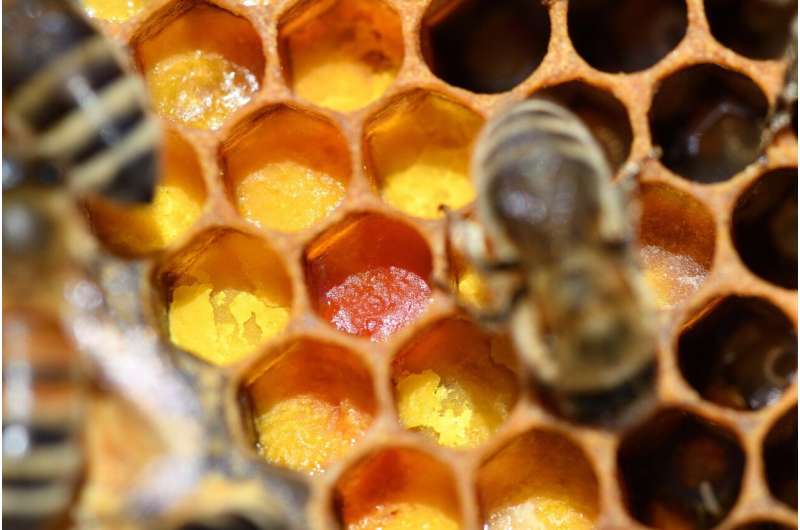Natural antimicrobial drugs found in pollen could help protect bee colonies from infection

Sadie Harley
scientific editor

Robert Egan
associate editor

A honeybee hive, with its large stores of pollen, wax, and honey, is like a fortress guarding treasure: with strong defenses, but a bonanza for enemies that can overcome those. More than 30 parasites of honeybees are known, spanning protists, viruses, bacteria, fungi, and arthropods—and this number keeps growing. As a result, beekeepers are always on the lookout for new ways to protect their precious hives.
A team of researchers from the US suspected that a rich new source of eco-friendly treatments for bee diseases might be hiding in plain sight: in the pollen gathered by bees. They reasoned that so-called endophytes, symbiotic bacteria and fungi living inside most plant tissues, should benefit when their hosts are pollinated. This could be an incentive for these microbes to evolve compounds that keep their host's pollinators healthy.
And now, they have shown their hunch to be correct.
"We found that the same beneficial bacteria occur in pollen stores of honeybee colonies and on pollen of nearby plants," said Dr. Daniel May, a faculty member at Washington College in Maryland, US, and the corresponding author of a study in .
"We also show that these bacteria produce similar antimicrobial compounds that kill pathogens of bees and plants, making them a great starting point for new treatments of crops and hives."
Precious pollen
May and colleagues homed in on bacteria from the phylum actinobacteria, the source of two-thirds of the antibiotics currently in clinical use. Between April and June 2021, they collected pollen from 10 native plant species in the Lakeshore Nature Preserve at the University of Wisconsin—Madison. They also collected pollen from the stores of a nearby honeybee hive.
The authors isolated 16 strains of actinobacteria from plants, and 18 strains from pollen stores inside the hive. DNA barcoding and genome sequencing revealed that the same or closely related species occurred in both types of samples.
The majority (72%) belonged to the genus Streptomyces, the source of many compounds used in medicine and agriculture, for example as antibiotics or as anticancer and antiparasitic drugs. Some of the closest relatives of the Streptomyces species found here are currently under study elsewhere as potential sources of compounds against diseases of crop plants.
The authors then conducted "competition assays," where known pathogens were grown together with the Streptomyces isolated here. Nearly all of these proved to be effective inhibitors of the mold Aspergillus niger, which can cause a honeybee disease called stonebrood.
Individual strains also proved moderately to strongly active against two bacterial pathogens of honeybees, Paenibacillus larvae and Serratia marcescens, and against three pathogens of crops, Erwinia amylavora, Pseudomonas syringae, and Ralstonia solanaceum.
'Whisked back to the hive'
"We isolated the same Streptomyces bacteria from flowers, pollen-covered bees leaving flowers, and hives. We conclude from our results that endophytic actinobacteria on pollen grains are picked up by pollinating bees and whisked back to hive pollen stores, where they help to defend the colony against disease," said May.
The authors found clear evidence in the genome of the sequenced species that they were indeed endophytes, rather than living in a loose, haphazard association with plants. They possessed genes encoding enzymes that allow Streptomyces to colonize plant tissue, produce hormones to boost the growth of their host, or scavenge metals around roots.
The results confirmed that a great variety of interesting bioactive compounds remain to be discovered in endophytes, many of which could help us to keep honeybees healthy. They also suggest that a landscape rich in plant species is beneficial for bees, as it ensures a greater diversity of actinobacterial endophytes available to them.
"In the future, treating bee diseases could be a matter of simply introducing the right beneficial bacteria into hives to help control specific pathogens," concluded May.
More information: Endophytic Streptomyces from Honeybee Hives Inhibit Plant and Honeybee Pathogens, Frontiers in Microbiology (2025).
Journal information: Frontiers in Microbiology
Provided by Frontiers




















